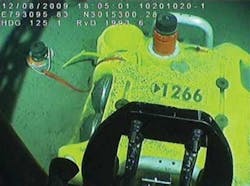New heavy lift vessel deploys in Gulf
Versabar reports that itsVB-10,000, a new catamaran heavy-lift vessel built in the US, has successfully completed its first heavy lift operation in the Gulf of Mexico. On Oct. 7, tugs towed the VB-10,000 through Aransas Pass, Texas, and into the Gulf of Mexico.
Just over 48 hours later, on Oct. 9, the vessel used its hook-height systems to bring up a 1,530-ton topside. Consisting of twin 240-ft (73-m) tall gantries mounted on custom-built barges, the vessel lifts with four independent blocks that can be controlled either separately or in synchronization. Versabar says that new lift system builds on its proven offshore lift designs, which include the design concepts incorporated in itsVersatruss and Bottom Feeder vessels.
Height and lift capacity
Over the first four seasons, the Bottom Feeder accomplished over 100 major subsea retrievals (including 31 topsides) totaling over 60,000 tons. The desire for greater hook-height and increased lift capacity prompted Versabar to contemplate dry-docking the system and modifying it accordingly. These plans were changed by two factors: first, a realization that the proposed modifications would make it difficult to optimize the lift capacity of the Bottom Feeder, and the environment had become favorable for exercising a new-build option.
There were numerous engineering, fabrication, and assembly challenges. First was the sheer weight and size of the new gantries. Being more than twice as tall as those of theBottom Feeder, they would be constructed of 60-in. pipe instead of the Bottom Feeder’s 48-in. pipe, which would render them three times as heavy, approximately 3,400 tons each. This would in turn mean that the system’s two barges would have to be engineered and fabricated with sufficient reinforcement to interface reactions under the gantries.
As these factors were taken into account, additional technical issues arose: the size and weight of the gantries meant that new assembly and load-out procedures would have to be devised, as yard cranes would be incapable of lifting or moving the assembled structures. The gantries would have to be constructed in pieces of manageable size and then mated, moved across the fabrication yard, and installed on the barges. These issues were addressed over a period of months as the steel was being rolled and the structural members cut and welded. A high degree of disciplined interdepartmental communication was essential to keep the various aspects of the assembly and load-out procedures on time and on target throughout the project.
Each gantry was fabricated in two sections: the designated 870-ton “wide-side” pieces and the 1,550-ton “narrow-side” pieces, named for their respective footprints. Each piece was fitted with two trunions, which were located at the midlines of the centers of gravity in order to create eccentric “hinges” upon which they could rotate when up-righted.
Once up-righted, the gantry sections were standing on the bulkhead facing one another. To mate the sections, an “A-frame” was used to perch the upper end of the narrow-side assembly, thus permitting yard cranes to “walk” the wide-side into position to pin the two pieces together.
Once pinned, the narrow-side was winched upright in a scissoring action until eight connection points were simultaneously joined.
Versabar engineers had initially envisioned a rail system upon which the 3,300-ton gantries could be moved to the barges. This plan was vetoed in favor of the use of transporters and a determinate tunnel load-spreader built to accommodate the number of transporters that would be required to perform the task.
The transport system had been designed that the end of the gantry that was to be placed aboard the barge was cantilevered out 80 ft beyond the transporters themselves, allowing for the heel pins to be “run out” beyond the bulkhead until they were positioned on the centerline of the barge.
At this point, the barge was deballasted, to bring the load-spreaders in contact with the pin carriages upon which the gantry was to be seated. Once the gantry was positioned, the transporters released the load, and the gantry welded in its final position. Once the process was repeated for the second gantry, the first system barge had a wide-side and a narrow-side gantry welded into position.
The convertible steel assemblies that had served as “in-riggers,” along with the tunnel load spreaders, were now shifted to the outside of the two gantries, achieving the cantilever effect that would enable the transporters to carry the load out over the bulkhead to the centerline of the second system barge.
The process was continued like the earlier load-outs, advancing the trusses into position over the second system barge. When the second barge was deballasted, the load spreaders rose to meet the pin carriages, the transporters then transferred load to the barges and theVB 10,000 became free-floating.
Once wiring and instrumentation of the vessel was completed, a test lift using a 2,740-ton water-filled barge was performed on each gantry. TheVB 10,000 was towed out on Oct. 7, 13 months after the first steel was cut and rolled. Two days later, on Oct. 9, at Vermillion 285, the VB 10,000 lowered its blocks into the sea and retrieved a 1,530-ton topside and jacket section which had toppled during a hurricane and was resting awkwardly on its side. A week later, it lifted a fire-damaged 2,500-ton topside from its jacket and placed it on a materials barge bound for a Gulf Coast salvage yard. This immediately demonstrated the value of the additional hook-height and the additional 50 ft between the system barges.
“As difficult as those lifts are,” remarked a Versabar engineer after the second lift, “they seem pretty routine compared to the challenge of assembly and load-out of the vessel itself.”
Offshore Articles Archives
View Oil and Gas Articles on PennEnergy.com



